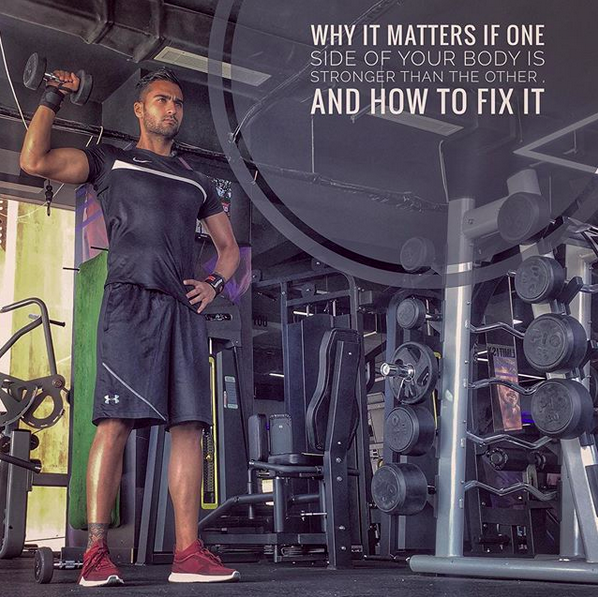Have you ever noticed that one side of your body is stronger or more dominant than the other? This is a common issue that many people face, and it’s known as muscle imbalance. Let’s explore why this happens and how you can address it.
Causes of Muscle Imbalances
- Dominant Side: Most people have a dominant hand or leg that they use more often in daily activities, leading to stronger muscles on that side.
- Improper Form: During exercises, you might unconsciously rely more on your stronger side to lift or push weight, further increasing the imbalance.
- Injuries: An injury on one side can lead to overcompensating with the other side, creating a strength gap.
- Postural Habits: Poor posture or repetitive movements can unevenly distribute muscle engagement, contributing to imbalances.

Why It Matters ?
Muscle imbalances can affect your performance, increase your risk of injury, and lead to poor alignment or posture over time.
Solutions for Muscle Imbalances
- Unilateral Exercises: Incorporate exercises that work one side at a time, such as:
- Dumbbell single-arm presses
- Single-leg squats
- One-arm rows
- Focus on Weak Side: Start your sets with the weaker side to ensure it gets the attention and energy it needs.
- Equal Repetitions: Perform the same number of reps on both sides, even if the weaker side struggles. Avoid letting the stronger side compensate.
- Assess Form: Work with a trainer or use a mirror to ensure proper form and equal effort on both sides.
- Stretch and Mobilize: Tight muscles can limit range of motion and contribute to imbalance. Incorporate stretches for the dominant side and strengthen the weaker side.
Example: Fixing a Dominant Right Arm
Let’s say John notices his right arm is stronger than his left. Here’s a sample plan to correct the imbalance:
Workout Plan:
- Single-Arm Dumbbell Press: 3 sets of 12 reps (start with the left arm)
- Single-Arm Row: 3 sets of 10 reps per side (use equal weight for both arms)
- Left-Arm Bicep Curl: 2 extra sets of 12 reps for the weaker side
- Stretch: Focus on the right shoulder and arm to improve flexibility and reduce dominance.
Over time, this approach helps balance strength, improve symmetry, and reduce the risk of injury.
Final Thoughts
Muscle imbalances are common and manageable with the right approach. By incorporating unilateral exercises, focusing on your weaker side, and maintaining proper form, you can achieve better strength symmetry and overall performance. Consistency and patience are key—you’ll see results with regular effort!
Addressing Muscle Imbalances: A Strategic Path to Balanced Performance
Have you noticed that one side of your body feels stronger or more dominant? This common occurrence, known as muscle imbalance, can have a significant impact on your overall physical performance and efficiency. Let’s delve into the root causes and strategies to correct this issue, ensuring balanced strength and improved functionality.
Understanding the Causes of Muscle Imbalances
- Dominant Side Usage
Most individuals have a dominant hand or leg they favor in daily tasks, leading to stronger muscles on that side. - Improper Exercise Form
Unconsciously relying on the stronger side during workouts can exacerbate the imbalance over time. - Injuries
Injuries often result in overcompensation by the uninjured side, widening the strength disparity. - Postural Habits
Repetitive motions or poor posture can cause uneven muscle engagement, contributing to long-term imbalances.
Why Muscle Imbalances Matter for Peak Performance
Muscle imbalances can:
- Hinder performance efficiency.
- Increase injury risk.
- Cause poor alignment and postural issues, impacting mobility and functionality.
Strategic Solutions for Correcting Muscle Imbalances
- Unilateral Training
Incorporate exercises that isolate and strengthen one side at a time, such as:
Dumbbell single-arm presses, Single-leg squats, One-arm rows.
- Prioritize the Weaker Side
Start each set with the weaker side to ensure it receives adequate focus and energy. - Maintain Repetition Parity
Perform equal repetitions for both sides, even if the weaker side fatigues faster. This prevents the stronger side from compensating. - Monitor and Refine Form
Work with a coach or use a mirror to ensure proper technique, minimizing reliance on the dominant side. - Stretch and Mobilize
Address tightness in the dominant side with targeted stretching, while incorporating strengthening exercises for the weaker side to improve range of motion and symmetry.
Case Study: Correcting a Dominant Right Arm
For example, if John observes his right arm is noticeably stronger than his left, a targeted workout plan could include:
- Single-Arm Dumbbell Press: 3 sets of 12 reps, starting with the left arm.
- Single-Arm Row: 3 sets of 10 reps per side, using equal weights.
- Left-Arm Bicep Curl: 2 extra sets of 12 reps exclusively for the weaker side.
- Stretching Routine: Focus on flexibility exercises for the dominant arm and shoulder.
This structured approach ensures balanced strength development while reducing the risk of future imbalances or injuries.
Key Takeaways for Balanced Strength and Peak Performance
Muscle imbalances are a common challenge but can be resolved with a strategic and consistent approach. By integrating unilateral exercises, prioritizing weaker muscles, and maintaining proper technique, you can enhance overall strength symmetry, reduce injury risk, and optimize performance. For leaders and executives prioritizing health and efficiency, addressing muscle imbalances is a critical step toward achieving physical resilience and peak productivity.
“Strength imbalances are just your body’s way of showing where the real work begins.”
— Erfun Sadri
Certified Personal Trainer | Fitness Coach
www.Pterfun.com |@erfan

